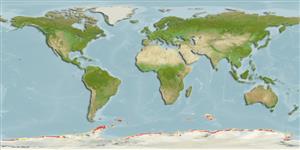Common names from other countries
Environment: milieu / climate zone / depth range / distribution range
Ecologie
; diepteverspreiding 1 - 508 m (Ref. 124196). Polar; 48°S - 78°S, 170°W - 170°E
Antarctic: Antarctica.
Length at first maturity / Size / Gewicht / Leeftijd
Maturity: Lm ? range ? - ? cm Max length : 8.3 cm SHL mannelijk/geslacht niet bekend; (Ref. 7659); Maximaal vermelde leeftijd: 13 jaren (Ref. 8072)
Life cycle and mating behavior
Geslachtsrijpheid | Voortplanting | Kuitschieten | Eieren | Fecundity | Larven
Members of the class Bivalvia are mostly gonochoric, some are protandric hermaphrodites. Life cycle: Embryos develop into free-swimming trocophore larvae, succeeded by the bivalve veliger, resembling a miniature clam.
MarineSpecies.org. 2050. (Ref. 3477)
Status op de Rode Lijst van het IUCN (Ref. 130435)
Status bij CITES (Ref. 108899)
Not Evaluated
Not Evaluated
Gevaarlijk voor mensen
Harmless
Gebruik door de mens
| FishSource |
Tools
Internet-bronnen
Estimates based on models
Preferred temperature
(Ref.
115969): -1.8 - -0.6, mean -1.5 (based on 214 cells).
Weerstandsvermogen
Gemiddeld, minimale populatieverdubbelingstijd 1,4-4,4 jaar (K=0.16; tmax=13).
Kwetsbaarheid
Moderate to high vulnerability (46 of 100).
Prijsklasse
Unknown.
